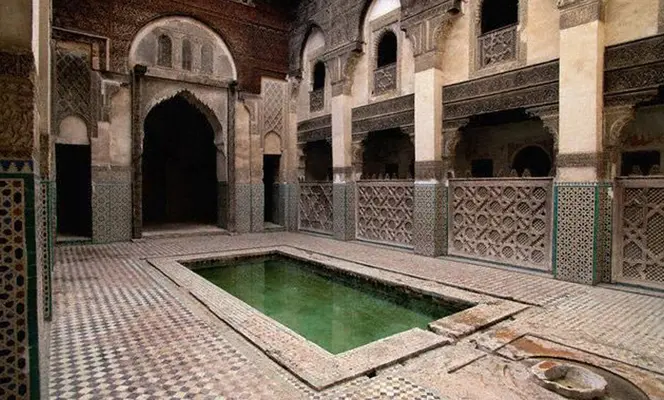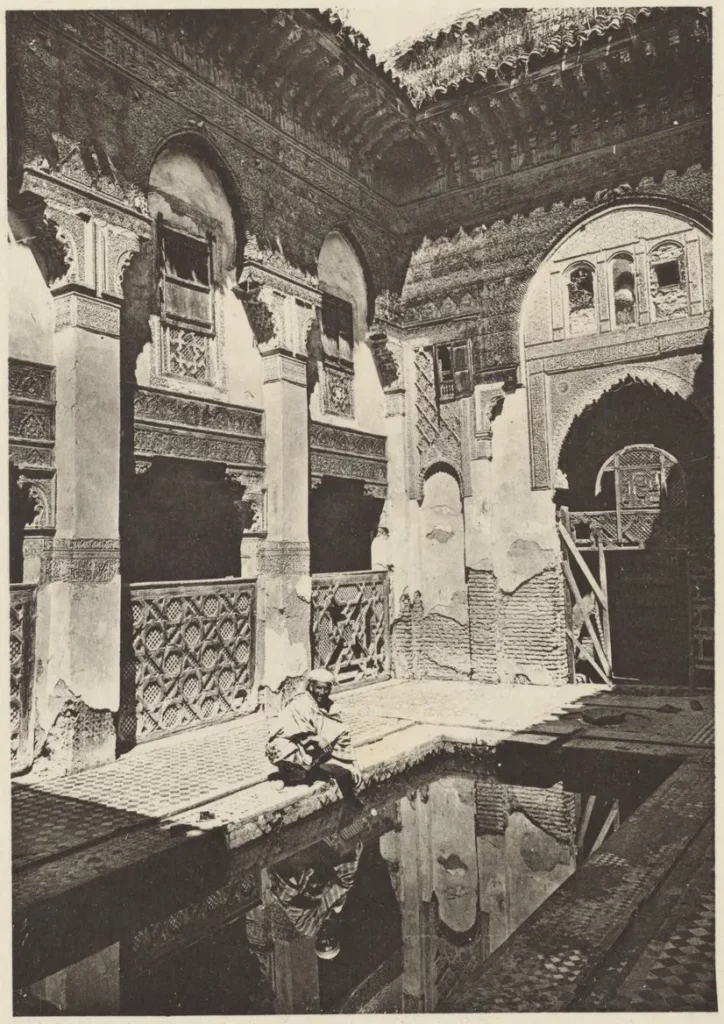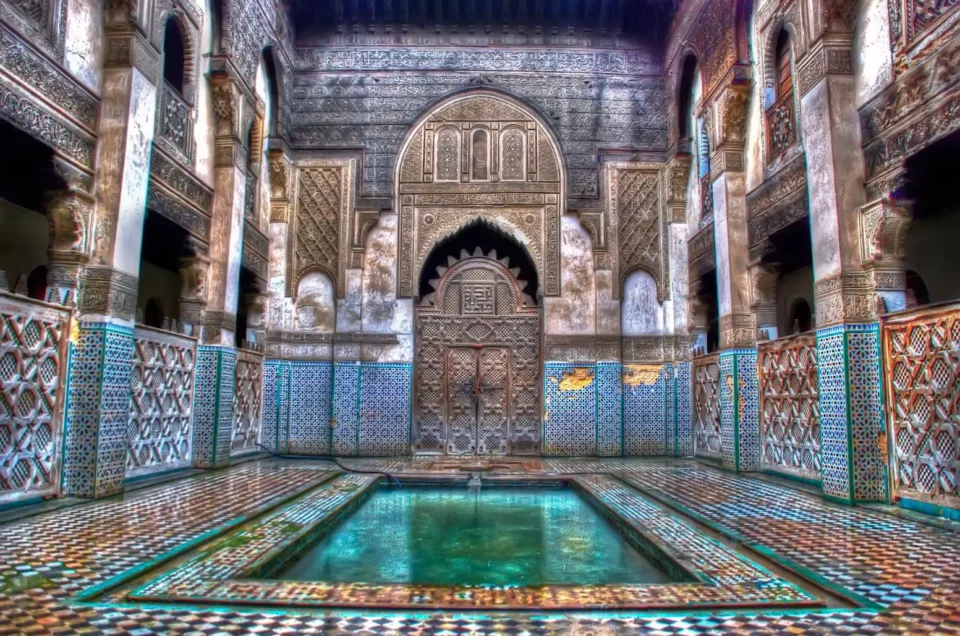Nestled in the heart of Fez, Morocco, Sahrij Madrasa stands as a testament to the grandeur of the Marinid dynasty. Established in the 14th century, this architectural marvel mesmerizes visitors with its intricate Moorish designs and profound historical significance. Renowned for its role in Islamic education and culture, Sahrij Madrasa continues to captivate those seeking to explore the depths of Moroccan heritage and architectural brilliance.

Historical Insights: The Origins of Sahrij Madrasa
The Sahrij Madrasa, a historical gem in Fez, Morocco, was established during the flourishing Marinid dynasty in the 14th century. Its creation marked an era of significant cultural and educational development, mirroring the dynasty’s dedication to learning and the arts.
As a cornerstone of Islamic education, the madrasa was not only a place of religious study but also a symbol of the societal values and intellectual vigor of the time. This institution played a pivotal role in shaping the educational landscape of Morocco, making it a crucial part of the country’s rich historical tapestry.
Architectural Splendor of Sahrij Madrasa
The Sahrij Madrasa is a masterpiece of Marinid architecture, epitomizing the splendor of Islamic art and design. Its structure features a harmonious blend of cedar wood, stucco, and intricately detailed tile work, creating a captivating visual experience.
The madrasa’s design is further distinguished by its impressive water basin, a unique element that symbolizes the fusion of functionality and aesthetic elegance.
This architectural marvel reflects the sophisticated craftsmanship and artistic creativity of the era, embodying the rich cultural heritage of Morocco.
The attention to detail in its design exemplifies the Marinid dynasty’s commitment to building institutions that were not only educational centers but also works of art, deeply embedded in the cultural and religious fabric of the society.
Sahrij Madrasa: A Hub of Culture and Education
Sahrij Madrasa was more than just a center of architectural beauty; it was a hub of culture and education in Fez. This institution played a crucial role in the Islamic world, offering religious and secular education. It exemplified the Marinid dynasty’s commitment to learning and scholarship, nurturing a community of scholars and thinkers.
The madrasa’s influence extended beyond its walls, significantly impacting the local community and contributing to the rich tapestry of Islamic scholarship. Its legacy as a center of knowledge and culture remains a significant chapter in Moroccan and Islamic history.
Preserving the Legacy: Restoration of Sahrij Madrasa
The preservation and restoration of Sahrij Madrasa are crucial to maintaining its historical and cultural significance.
Recent efforts have focused on reviving its architectural grandeur, ensuring that the intricate designs and structural integrity are restored to their original splendor. These efforts symbolize a deep respect for the past and a commitment to preserving heritage for future generations.
The restoration of Sahrij Madrasa not only serves to protect a significant historical landmark but also to reinvigorate interest in the rich history and architectural heritage of Morocco.
These endeavors underscore the importance of safeguarding historical sites as living testimonies of a bygone era, ensuring that their stories and contributions to culture and education continue to inspire and educate.

Planning Your Visit to Sahrij Madrasa
Planning your visit to Sahrij Madrasa is an exciting opportunity to step into the pages of history. Located in the vibrant city of Fez, the madrasa is easily accessible and offers a unique glimpse into Morocco’s rich heritage.
Before you go, here are some tips to make your visit enjoyable and respectful:
- Check Opening Hours: Ensure you know the opening times to plan your visit accordingly.
- Entry Fees: There may be a small fee for entry, contributing to the madrasa’s maintenance and preservation.
- Photography: Capture the beauty of the madrasa, but remember to be respectful of any photography rules.
- Dress Code: As a place of historical and cultural significance, dressing modestly is appreciated.
- Guided Tours: Consider joining a guided tour to gain deeper insights into the madrasa’s history and architecture.
- Etiquette: As a revered historical site, it’s important to be mindful and respectful during your visit.
Remember, your visit not only offers a chance to witness the splendor of Moroccan architecture but also supports the ongoing preservation of this historical treasure.
Nearby Historical Attractions
The vicinity of Sahrij Madrasa in Fez is rich with historical and cultural sites, offering a plethora of experiences for visitors.
After exploring the madrasa, you can immerse yourself in the vibrant atmosphere of Fez’s old city, known for its medieval architecture and bustling souks.
Nearby attractions include the famous Al Quaraouiyine University, one of the oldest universities in the world, and the Bou Inania Madrasa, another architectural marvel. The city’s tanneries, with their iconic colorful dye pits, offer a unique glimpse into traditional Moroccan craftsmanship. Strolling through the narrow streets, you’ll encounter a variety of local artisans and vibrant markets, each telling a story of Fez’s rich cultural tapestry.
This area is a treasure trove for those interested in history, culture, and the timeless charm of Moroccan life.
Conclusion
Sahrij Madrasa, with its rich history, stunning architecture, and cultural significance, stands as a testament to Morocco’s grand past. This historic site is not just a monument to admire but a gateway to understanding the depth and diversity of Moroccan heritage.
A visit here offers a unique blend of educational insight and aesthetic pleasure, making it a must-see for anyone interested in the rich tapestry of Islamic education, art, and architecture.
Sahrij Madrasa, therefore, remains an enduring symbol of Fez’s historical and cultural legacy, inviting visitors to step back in time and explore the wonders of the Marinid era.

